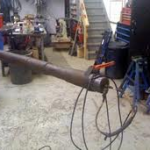Company president advocates direct testing of selected stages in each horizontal well bore.
From the Calgary Herald, Canada, November 22, 2012
The energy industry is pouring vast amounts of horsepower, water and money into shale formations with little or no proof it’s the most cost-effective practice, says Ron Craik, president of Horizontal Well Testing Ltd. This company has patents on testing tools he says will ultimately save money, times and reduce the environmental footprint of horizontal drilling and formation fracturing.
Schlumberger CEO Paal Kibsgaard has recently called established practices “indiscriminate fracking.” Kibsgaard was referring to the use of 10 to 20 staged fracture operations performed on a single, very long horizontal well to access oil or natural gas.
In the past five years the routine use of horizontal drilling and multi-stage fracking has exploded in North America, accounting for 60 per cent of wells drilled in the United States and up to 80 per cent of wells in Canada. Multiple, very-high-pressure, hydraulic fractures are used to break open vast and previously uneconomic shale formations, /releasing billions of dollars worth of new oil and gas production every year.
So-called ‘horizontal multi-fracks’ have become so successful and widespread that the U.S. expects to reverse its dependence on increasing supplies of foreign oil, eliminating some 12 million barrels of daily crude imports and becoming self sufficient within a decade.
But Craik says new production is costing far more than it should — and volumes could fall off just as fast as they rise. “They’re using brute force on these formations without ever really knowing what’s down there or how much they’re leaving behind when those wells water out,” he says. They often water out, not because of resource depletion, but because they’ve been fractured in the wrong places, Craik says.
While horizontal wells frequently cost $5 million each, Craik estimates $2 million to $3 million of that is wasted on fractures that are actually damaging productivity, as well as on drilling wells farther out than they can be effectively produced. While wells are often drilled up to 1.5 kilometres in horizontal reach, there’s increasing suspicion that no significant production is achieved beyond 800 metres. Testing, says Craik, would resolve the debate.
Schlumberger’s Kibsgaard told an energy conference in New Orleans that increased use of seismic technology and computerized reservoir modeling are needed to end the ongoing waste of money and water resources. But Craik advocates direct testing of selected stages/zones in each horizontal well bore to identify where fracturing should and should not be done.
Meaningful testing of horizontal wells has been difficult because established methods developed for conventional vertical wells often rely on drill string rotation for the operation of mechanical tools. Turning the drill stem is a cumbersome and imprecise business when wellbores are deviated by 90 degrees underground.
Craik says his company can provide quick and accurate testing of horizontal wells because it holds the patents on a complete system of electronically-controlled testing tools that can be delivered downhole on a drill string and remotely controlled by wireline connection to a laptop-computer-and-mouse arrangement on the surface.
Testing tools are similar to mechanical “straddle-inflate” systems, but electronically operated. The key difference is electronic control allows tests to be conducted reliably in horizontal wells, where mechanical control is difficult and unreliable. Inflatable packers are placed on either end of a section of drill string with an open-and-close valve between packers. This assembly is placed into the desired test section of the well, packers are inflated to seal off the section and the valve is opened to allow production to flow into the drill stem. Measurements are taken and results are relayed to the surface.
Judicious use of well testing could prevent fracturing water-filled portions of a formation that choke off production, argues Craik. Testing, he says, would also show whether wells are able to produce beyond 800 metres.
Craik and Kibsgaard are running head-on into the industry dogma of “repeatability” — that the best way to attack vast expanses of shale is to rapidly drill large numbers of wells in quick succession, cutting costs by reducing drilling time. This logic has extended to quickly fracturing the entire length of each well and moving on to the next. Anything that slows down drilling and completion increases costs.
Also, testing can be selective. The first well in a formation might be fully tested and mapped, with one or two successive wells spot-tested to reliably map water flows, natural fractures and areas of best permeability. A great deal of unnecessary fracturing could then be eliminated and water flows that choke off hydrocarbon production could be avoided.

